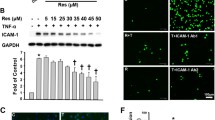Abstract
Endothelial inflammation and monocyte plays an essential role in the initiation and progression of atherosclerosis. Ghrelin is beneficial for atherosclerosis progression. However, the detailed and precise molecular mechanisms of how ghrelin regulates endothelial inflammation are not clear. In this study, we investigated the regulation mechanism of ghrelin on TNF-α-activated endothelial inflammation and monocyte adhesion. It was found that TNF-α-induced monocyte adhesion on HUVEC was significantly attenuated by ghrelin. Furthermore, we found that ghrelin effectively suppressed TNF-α-induced inflammatory factors’ (including ICAM-1, VCAM-1, MCP-1, and IL-1β) expression through inhibiting AMPK phosphorylation and p65 expression both in HUVEC and THP-1. This phenomenon was further demonstrated by using AMPK agonist AICAR and inhibitor compound C, respectively. Our findings suggest that ghrelin may mediate TNF-α-induced endothelial inflammation and monocyte adhesion, in part via AMPK/NF-κB signaling pathway. These novel anti-inflammatory and immunoregulatory actions of ghrelin may play a certain role in understanding the formation and development of atherosclerosis.








Similar content being viewed by others
References
Zheng XX, Zhou T, Wang XA, Tong XH, Ding JW (2015) Histone deacetylases and atherosclerosis. Atherosclerosis 240(2):355–366. doi:10.1016/j.atherosclerosis.2014.12.048
Gimbrone MA, Garcia-Cardena G (2016) Endothelial cell dysfunction and the pathobiology of atherosclerosis. Circ Res 118(4):620–636. doi:10.1161/CIRCRESAHA.115.306301
Pober JS, Sessa WC (2007) Evolving functions of endothelial cells in inflammation. Nat Rev Immunol 7(10):803–815. doi:10.1038/nri2171
Nakashima Y, Raines EW, Plump AS, Breslow JL, Ross R (1998) Upregulation of VCAM-1 and ICAM-1 at atherosclerosis-prone sites on the endothelium in the ApoE-deficient mouse. Arterioscler Thromb Vasc Biol 18(5):842–851
Gahete MD, Rincon-Fernandez D, Villa-Osaba A, Hormaechea-Agulla D, Ibanez-Costa A, Martinez-Fuentes AJ, Gracia-Navarro F, Castano JP, Luque RM (2014) Ghrelin gene products, receptors, and GOAT enzyme: biological and pathophysiological insight. J Endocrinol 220(1):R1–24. doi:10.1530/JOE-13-0391
Hattori N (2009) Expression, regulation and biological actions of growth hormone (GH) and ghrelin in the immune system. Growth Horm IGF Res 19(3):187–197. doi:10.1016/j.ghir.2008.12.001
Baatar D, Patel K, Taub DD (2011) The effects of ghrelin on inflammation and the immune system. Mol Cell Endocrinol 340(1):44–58. doi:10.1016/j.mce.2011.04.019
Zhan M, Yuan F, Liu H, Chen H, Qiu X, Fang W (2008) Inhibition of proliferation and apoptosis of vascular smooth muscle cells by ghrelin. Acta Biochim Biophys Sin (Shanghai) 40(9):769–776
Deng B, Fang F, Yang T, Yu Z, Zhang B, Xie X (2015) Ghrelin inhibits AngII-induced expression of TNF-alpha, IL-8, MCP-1 in human umbilical vein endothelial cells. Int J Clin Exp Med 8(1):579–588
Carling D, Mayer FV, Sanders MJ, Gamblin SJ (2011) AMP-activated protein kinase: nature’s energy sensor. Nat Chem Biol 7(8):512–518. doi:10.1038/nchembio.610
Zeng Y, Li C, Guan M, Zheng Z, Li J, Xu W, Wang L, He F, Xue Y (2014) The DPP-4 inhibitor sitagliptin attenuates the progress of atherosclerosis in apolipoprotein-E-knockout mice via AMPK- and MAPK-dependent mechanisms. Cardiovasc Diabetol 13:32. doi:10.1186/1475-2840-13-32
Fullerton MD, Steinberg GR, Schertzer JD (2013) Immunometabolism of AMPK in insulin resistance and atherosclerosis. Mol Cell Endocrinol 366(2):224–234. doi:10.1016/j.mce.2012.02.004
Collins T, Cybulsky MI (2001) NF-kappaB: pivotal mediator or innocent bystander in atherogenesis? J Clin Invest 107(3):255–264. doi:10.1172/JCI10373
Xia YF, Liu LP, Zhong CP, Geng JG (2001) NF-kappaB activation for constitutive expression of VCAM-1 and ICAM-1 on B lymphocytes and plasma cells. Biochem Biophys Res Commun 289(4):851–856. doi:10.1006/bbrc.2001.6067
Zhang Z, Yuan W, Sun L, Szeto FL, Wong KE, Li X, Kong J, Li YC (2007) 1,25-Dihydroxyvitamin D3 targeting of NF-kappaB suppresses high glucose-induced MCP-1 expression in mesangial cells. Kidney Int 72(2):193–201. doi:10.1038/sj.ki.5002296
Wang Y, Zhang JJ, Dai W, Lei KY, Pike JW (1997) Dexamethasone potently enhances phorbol ester-induced IL-1beta gene expression and nuclear factor NF-kappaB activation. J Immunol 159(2):534–537
Jung CH, Lee MJ, Kang YM, Lee YL, Seol SM, Yoon HK, Kang SW, Lee WJ, Park JY (2016) C1q/TNF-related protein-9 inhibits cytokine-induced vascular inflammation and leukocyte adhesiveness via AMP-activated protein kinase activation in endothelial cells. Mol Cell Endocrinol 419:235–243. doi:10.1016/j.mce.2015.10.023
Zabielska MA, Borkowski T, Slominska EM, Smolenski RT (2015) Inhibition of AMP deaminase as therapeutic target in cardiovascular pathology. Pharmacol Rep 67(4):682–688. doi:10.1016/j.pharep.2015.04.007
Guo Y, Zhang Y, Hong K, Luo F, Gu Q, Lu N, Bai A (2014) AMPK inhibition blocks ROS-NFkappaB signaling and attenuates endotoxemia-induced liver injury. PLoS ONE 9(1):e86881. doi:10.1371/journal.pone.0086881
Tesauro M, Schinzari F, Iantorno M, Rizza S, Melina D, Lauro D, Cardillo C (2005) Ghrelin improves endothelial function in patients with metabolic syndrome. Circulation 112(19):2986–2992. doi:10.1161/CIRCULATIONAHA.105.553883
Lilleness BM, Frishman WH (2016) Ghrelin and the cardiovascular system. Cardiol Rev. doi:10.1097/CRD.0000000000000113
Acknowledgements
The authors are thankful for the financial support from the National Nature Science Foundation of China (No. 81370400), Basic research foundation on Shanghai Institute of Science and Technology (10JC1405600), Shanghai Jiaotong University Grants for Interdisciplinary Research on Medicine and Engineering (YG-2014MS74), Research Fund for the Scientific and Technical Project of Shanghai Chest Hospital (2014YZDH20300), and the National Nature Science Foundation of China (No. 81370361).
Author information
Authors and Affiliations
Corresponding authors
Ethics declarations
Conflict of interest
The authors declare that they have no conflict of interest.
Ethical approval
This article does not contain any studies with human participants or animals performed by any of the authors.
Electronic supplementary material
Below is the link to the electronic supplementary material.
11010_2017_3094_MOESM1_ESM.tif
Supplementary material 1 Supplementary Fig. 1 Ghrelin attenuated TNF-α-induced inflammatory factors expression in HUVEC. (A) HUVEC was stimulated with ghrelin (1000 ng/mL or 3000 ng/mL) for 6 hours. MCP-1 mRNA expressions was analyzed by real-time PCR. (B) HUVEC was stimulated with ghrelin (1000 ng/mL or 3000 ng/mL) for 6 hours. IL-1β mRNA expressions was analyzed by real-time PCR. (TIFF 381 kb)
11010_2017_3094_MOESM2_ESM.tif
Supplementary material 2 Supplementary Fig. 2 Ghrelin attenuated TNF-α-induced inflammatory factors expression in THP-1. (A) THP-1 was stimulated with ghrelin (1000 ng/mL or 3000 ng/mL) for 6 hours. IL-8 mRNA expressions was analyzed by real-time PCR. (B) THP-1 was stimulated with ghrelin (1000 ng/mL or 3000 ng/mL) for 6 hours. MCP-1 mRNA expressions was analyzed by real-time PCR. (TIFF 517 kb)
Rights and permissions
About this article
Cite this article
Zhang, M., Wang, S., Pan, Z. et al. AMPK/NF-κB signaling pathway regulated by ghrelin participates in the regulation of HUVEC and THP1 Inflammation. Mol Cell Biochem 437, 45–53 (2018). https://doi.org/10.1007/s11010-017-3094-x
Received:
Accepted:
Published:
Issue Date:
DOI: https://doi.org/10.1007/s11010-017-3094-x




